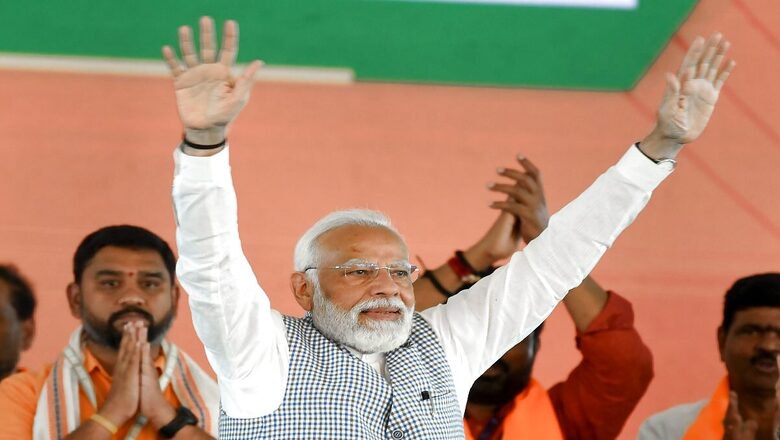
views
In the last decade, per capita milk availability has increased by 40 per cent. The first free vaccination campaign is underway to protect animals from foot and mouth diseases. So far, more than 50 crore doses have been administered to animals in four phases. Studies conducted by various institutions in recent years have found that the construction of 11 crore toilets and the elimination of open defecation have prevented the incidence of many diseases. As a result of a toilet, every poor household in the urban area is saving up to Rs 60,000 per year on medical expenses.
The supply of piped drinking water is saving the lives of lakhs of children every year. The construction of pucca houses under the PM Awas Yojana has enhanced the social status and dignity of the beneficiary families. Education of children in families having pucca houses has improved and has resulted in a decline in the dropout rates. Under the Pradhan Mantri Surakshit Matritva Abhiyan, 100 per cent institutional deliveries are taking place in the country today. This has resulted in a sharp decline in the maternal mortality rate. According to another study, the incidence of serious diseases has reduced in the Ujjwala beneficiary families.
The Modi government is focused on human-centric development, where the dignity of every citizen is paramount. This is Modi’s idea of social justice. This is also the spirit of every article of the Constitution of India. For a long time, there was discussion only on rights. But Modi also stressed on the duties of the government. This has awakened a sense of duty among the citizens also. Today, a feeling has been generated that the performance of one’s duties ensures a guarantee of one’s rights.
PM Modi has cared for those who have so far been away from the development stream. During the last 10 years, thousands of tribal villages have been provided with electricity and road connectivity for the first time. Lakhs of tribal families have now started getting piped water supply and 4G internet connectivity too. The establishment of Van Dhan Kendras and MSP on more than 90 forest products has immensely benefited the tribals. For the first time, the Modi government has focused on the development of the particularly vulnerable tribal groups (PVTGs). PM Janman Yojana with an outlay of around Rs 24,000 crore has been launched for these groups.
Generations of tribal families have been afflicted with sickle cell anaemia. For the first time, a national mission has been launched to address this. So far, about 1.4 crore people have been screened under this mission. The Modi government has also launched the ‘Sugamya Bharat Abhiyan’ for the “Divyangjan”. Textbooks in Indian sign language have been made available. A law has also been enacted to give a respectable position to transgender persons in society and protect their rights.
It is difficult to imagine daily life without Vishwakarma families. These families pass on their skills from generation to generation. However, due to a lack of government support, Vishwakarma companions were facing a difficult time. So far, however, under the aegis of PM Modi, more than 84 lakh people have connected with the PM Vishwakarma Yojana and prospects for our artisans have never looked better.
For many decades, street vendors were also left to their fate. The Modi government has given them access to the banking system through PM SVANidhi Yojana. So far, an amount of more than Rs 10,000 crore has been given as collateral-free loans. Majority of the beneficiaries are Dalits, backward classes, tribals and women. Modi’s mantra of “Sabka Saath, Sabka Vikas, Sabka Vishwas and Sabka Prayas” is committed to providing fair opportunities to every section of the society. For the first time, the benefit of reservation has been extended to persons belonging to economically weaker sections (EWS) of the general category. 27 per cent reservation has been introduced under the Central quota for OBCs in undergraduate and postgraduate medical courses. Constitutional status has been granted to the National Commission for Backward Classes (NCBC). Five places associated with Baba Saheb Ambedkar have been developed as Panchteerth and 10 museums dedicated to tribal freedom fighters are being built across the country.
Thanks to Narendra Modi’s vision and farsightedness, for the first time, development has been brought to areas which remained neglected for decades. The villages adjoining our borders were viewed as the last villages of the country by the previous Congress regime. Modi recognised them as the first villages of the country. In order to develop these villages, the Vibrant Village programme has been started.
Our remote and faraway islands like Andaman and Nicobar and Lakshadweep were also deprived of development. The Modi government has developed modern facilities on these islands too. Roads, air connectivity and high-speed internet facilities have been provided there. Just a few weeks ago, Lakshadweep was also connected with underwater optical fibre. This will benefit the local population as well as millions of tourists.
Under the ‘Aspirational Districts’ programme, Modi has laid emphasis on the development of more than 100 districts of the country. In the wake of its success, the government has also launched the ‘Aspirational Blocks’ programme. Special focus is now being given to the development of these blocks of the country which had lagged behind for decades due to the apathy of successive Congress dispensations.
The tangible results of the Modi government’s efforts to strengthen internal security are visible to us. There is a sense of security in Jammu and Kashmir today. The earlier deserted look of marketplaces due to strikes has been replaced by the hustle and bustle of crowded markets. There has been a significant reduction in the incidents of separatism in the Northeast. Naxal-affected areas have shrunk and there has been a steep decline in Naxal violence. AFSPA has been removed from many areas in the Northeast.
Modi’s vision also has a programme for not merely the next five years but a roadmap for the next 25 years too. The vision of Viksit Bharat is not limited to economic prosperity alone but giving equal importance to social, cultural and strategic strengths. Today, every agency in the world is assured of India’s rapid development. Record investments in infrastructure and policy reforms are further boosting investors’ confidence.
Today, the world believes that only India can strengthen the global supply chain. A strong network of MSMEs is therefore being developed in the country. The Modi government has started PLI schemes for 14 sectors. Under this scheme, production of around Rs 9 lakh crore has taken place so far. This has generated lakhs of new employment and self-employment opportunities in the country. PLI is also benefiting the electronic, pharma, food processing and medical devices sectors. Production has started in dozens of projects related to medical devices, with the development of three bulk drug parks in the country.
Today, ‘Made in India’ has become a global brand. The world is appreciating the objective of Atmanirbhar Bharat. Today, companies from all over the world are excited about the emerging sectors in India. This is illustrated by investments in the semiconductor sector. The electronics and automobile sectors also stand to benefit significantly from the semiconductor sector.
The Modi government is promoting green mobility in a big way. Lakhs of electric vehicles have been manufactured in the country in the last few years alone. Today, there is a special demand for environmentally friendly products. That is why PM Modi has been repeatedly emphasising on ‘Zero Effect Zero Defect’, with a lot of focus on green energy. In the last 10 years, non-fossil fuel-based energy capacity has increased from 81 gigawatts to 188 gigawatts. During this period, solar power capacity has increased by 26 times. Similarly, wind power capacity has doubled.
India is placed at fourth position in the world in terms of installed capacity in renewable energy, fourth in wind power capacity and fifth in solar power capacity. India has set a target of achieving 50 per cent of its electric power installed capacity from non-fossil fuels by 2030. In the last 10 years, 11 new solar parks have been built. Today, work is in progress on nine solar parks.
Just a few weeks ago, a new scheme for solar rooftop installation was launched. 1 crore families will be provided assistance under this scheme. This will also reduce electricity bills and surplus electricity generated will be purchased in the power market. Work is also being done at a very fast pace in the field of nuclear energy, with approval for 10 new nuclear power plants. India is also progressing at a fast pace in the field of hydrogen energy. So far, the Modi government has started two projects in Ladakh and Daman and Diu. Unprecedented work is being done in the field of ethanol. The country has achieved the target of 12 per cent ethanol blending. The target of 20 per cent ethanol blending is also going to be accomplished very soon. This will increase the income of our farmers. Till now, government-owned companies have procured ethanol worth more than Rs one lakh crore. All these efforts will reduce dependence on foreign countries for our energy needs. Just a few weeks ago, oil production started in a new block in the Bay of Bengal.
The quantity of important minerals on Earth is limited. That is why the Modi government is encouraging a circular economy. India’s first ‘Vehicle Scrappage Policy’ also seeks to achieve this aim. It is important to explore the prospects of minerals through deep-sea mining. The Deep Ocean mission has been started with this goal in mind. This mission will better our understanding of marine life. India’s ‘Samudrayaan’ is engaged in research on this.
The Modi government is engaged in making India a major space power in the world. It is a means to improve human life. Besides, this also attempts to increase India’s share in the space economy. Major decisions have been taken to expand India’s space programme. This has led to the formation of many new space startups. The day is not far when India’s Gaganyaan will reach space. From Chandrayaan to Aditya L-1 mission, PM Modi’s focus on science and technology shines through. It has been Modi’s constant endeavour that India remains at the forefront of the world in the fourth industrial revolution, with a sharp focus on areas like artificial intelligence (AI). This will provide new opportunities to the youth of India and bring revolutionary changes in the fields of agriculture, health and education. The Modi government has also approved the National Quantum Mission. Quantum computing will develop a new-age digital infrastructure. Speaking of education, a new national education policy (NEP) was framed in 2020 and is being implemented rapidly. To provide quality education to school students, the Modi government is working on more than 14,000 ‘PM Shri Vidyalayas’. Out of these, more than 6000 schools have started functioning. The dropout rate in the country has reduced and the enrollment of girls in higher education has increased. Enrolment of Scheduled Caste students has increased by about 44 per cent, of Scheduled Tribe students by more than 65 per cent and of OBC by more than 44 per cent.
Tourism is a big sector providing employment to the youth. In the last 10 years, the Modi government has done unprecedented work in the field of tourism. Along with the number of domestic tourists in India, the number of foreign tourists coming to India has also increased. The reason for this growth is due to India’s growing stature. Today, the world wants to explore and know India. Apart from this, the scope of tourism has also increased due to excellent connectivity. Now, the Northeast is witnessing record tourist arrivals. There is also heightened excitement about Andaman and Nicobar and Lakshadweep islands. PM Modi has laid emphasis on the development of pilgrimage destinations and historical sites across the country. This has now made pilgrimage in India easier. At the same time, there is a growing interest in the world towards heritage tourism in India. In the last year, 8.5 crore people have visited Kashi. More than 5 crore people have visited Mahakaal. More than 19 lakh people have visited Kedar Dham. In the five days of Pran Pratishtha, 13 lakh devotees have visited Ayodhya Dham itself.
The Modi government also wants to make India a leading destination for meetings and exhibition-related sectors. For this, facilities like Bharat Mandapam and Yashobhoomi have been created. In the near future, tourism will become a major source of employment.
Today, India is moving towards becoming a great sporting power. We have developed dozens of Centres of Excellence in the country and a National Sports University has been established. This will provide youth with an opportunity to choose sports as a profession. In the last 10 years, India has successfully organised international sports events. ‘Mera Yuva Bharat’ organisation has been formed to motivate our youth to contribute to building a ‘Viksit Bharat’ and to instill among them a sense of duty and spirit of service. So far, about 1 crore youth have joined this initiative.
It is because of India’s role as ‘Vishwa Mitra’ that we have become the voice of the Global South today. The whole world appreciated the historic G20 Summit held in India. The unanimous adoption of the Delhi Declaration even in a fractured environment is historic. India’s vision from women-led development to environmental issues has become the basis of the declaration. Modi’s efforts to secure permanent membership of the African Union in the G20 have also been appreciated. During India’s G20 leadership, the development of the India-Middle East-Europe Corridor was announced. This corridor will strengthen India’s maritime capability. The launch of the Global Biofuel Alliance is also a big event. Such steps are expanding India’s role in solving global problems.
Today, India is a leading voice in the world against terrorism. Wherever there is a crisis in the world, India tries to respond promptly, through measures like Operation Ganga and Operation Kaveri. The Modi government has made continuous efforts to propagate the Indian traditions of Yoga, Pranayam and Ayurveda to the entire world. Last year, representatives of 135 countries did yoga together at the United Nations headquarters. This is a record in itself. The Modi government set up a new ministry for the development of Ayush. The World Health Organisation’s (WHO) first global centre for traditional medicine is being established in Gujarat, India.
They say good politics is all about good economics. Indeed that being so, the National Statistical Office (NSO) raised India’s real GDP growth estimate for 2023-24 (FY24) to 7.6 per cent from the 7.3 per cent projected last month. The growth estimate for FY23 is revised to 7 per cent and for FY22, the estimate has been upped from 9.1 per cent to a massive 9.7 per cent. GDP growth for the first two quarters of FY24 stands upwardly revised to 8.2 per cent and 8.1 per cent, from 7.8 per cent and 7.6 per cent respectively. Most importantly, for the October to December 2023 quarter (Q3FY24), the GDP growth rate has come in at a whopping 8.4 per cent, belying consensus expectations that ranged between 4-5 per cent. Private consumption grew 3.5 per cent in Q3 from 2.4 per cent in Q2. To cut to the chase, the average GDP growth for the first three quarters of FY24 is 8.23 per cent. Assuming that 4Q GDP growth is 7 per cent, India will end FY24 with a GDP growth of 7.925 per cent. Growing consistently at over 7.5 per cent when large parts of the world are deflating, stagnating or disinflating, is an ode to Modinomics, PM Modi’s relentless fight to push ahead with structural reforms without bothering about political expediency and above all, it is a testament to Modi’s grand vision combined with flawless execution.
There is no room for incrementalism in PM Modi’s larger scheme of things and the sharp rebound in the Indian economy despite two global Black Swan events is an endorsement of how India under Modi, in the last 10 years, has combined transparent politics with responsible economics.
Concluded
Sanju Verma is an Economist, National Spokesperson of the BJP and the Bestselling Author of ‘The Modi Gambit’. Views expressed in the above piece are personal and solely that of the author. They do not necessarily reflect News18’s views.



















Comments
0 comment